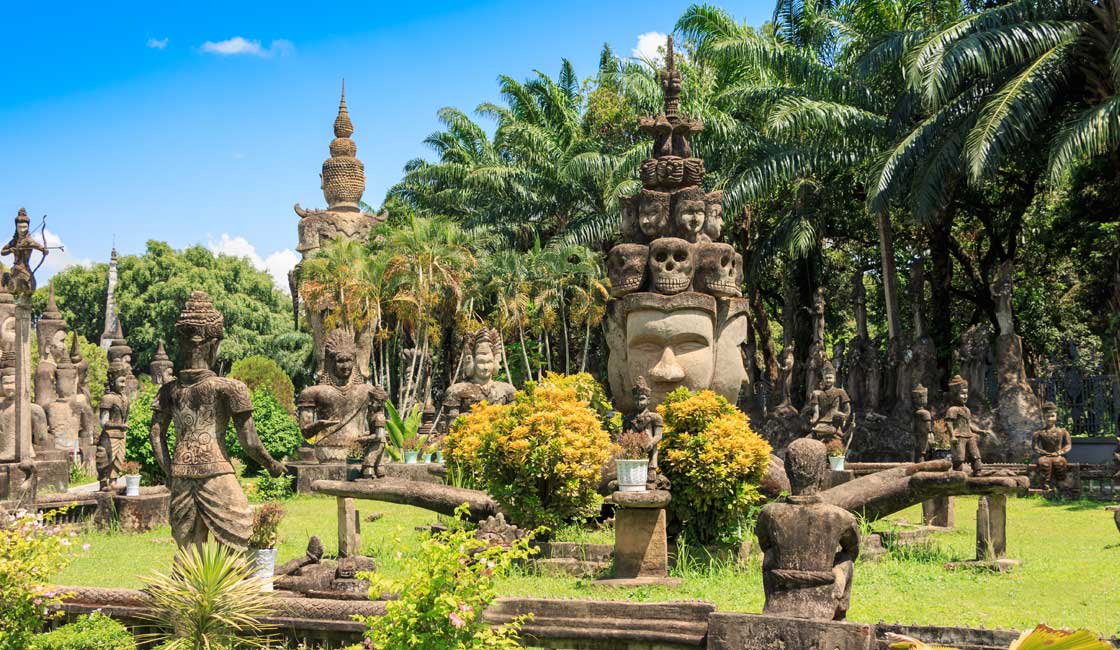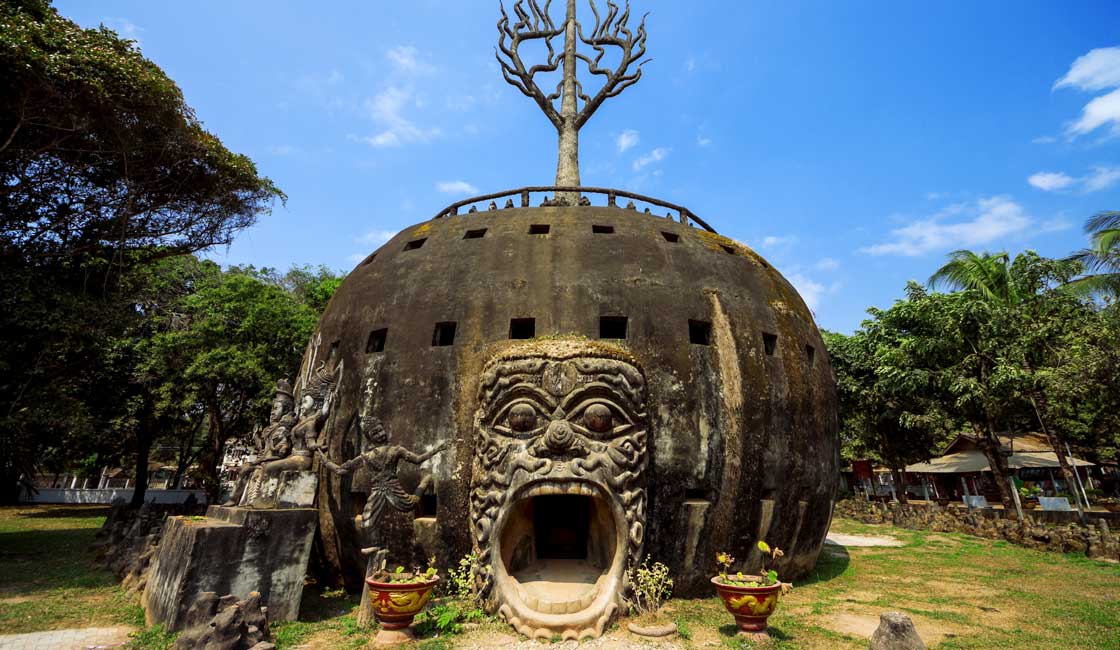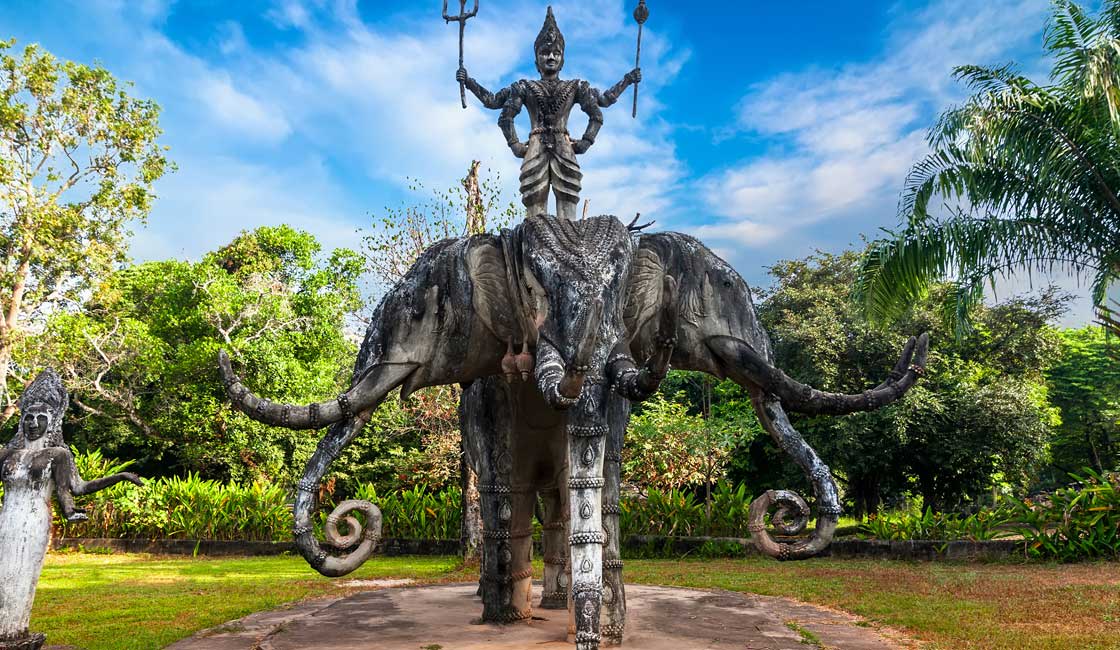
So you find yourself with a few days to fill in Vientiane, Laos. Perhaps you’re using it as a backpacking stopover while traveling from Laos to Thailand or Vietnam, or as a place to recuperate in amid other adventures on and around the Mekong River. You’ve done a bit of digging and come up short – by many accounts, there’s not all that much to do in this Southeast Asian capital. Well, that’s where you’re wrong!
Vientiane might be a small capital city with a slow pace to its streets, but it’s also home to one of Southeast Asia’s most wacky and unexpected features – the weird and wonderful Buddha Park. In this post, we’re going to dive headfirst into what must be the craziest of Laos attractions, and give you the lowdown on the history of this eccentric Buddhist and Hindu sculpture park, how to get there, the dress code, entrance fees and much more.

Park invites a thorough exploration
In basic terms, Buddha Park is an open-air sculpture park located about 25 kilometers (15 miles) outside of Vientiane on the river Mekong. It’s known by locals as Xieng Khuan which means Spirit City, and it’s the quirky setting of over 200 sculptures of various shapes and sizes depicting figures from Buddhist and Hindu traditions and lore.
Visitors are free to wander between the statues among the tranquil greenery of the banks of the Mekong, take photographs, and in some cases climb the structures. Although the statues and sculptures seem ancient and appear to be carved from stone, in reality, this park is relatively new. It was founded in 1958, and the sculptures themselves are mostly cast in reinforced concrete. Today, the park is run by the Lao government as a tourist attraction, and in 2017 it underwent heavy renovations, with added walkways and good quality toilets.
So what makes it so unique? Xieng Khuan is totally unlike anywhere else because of its twin devotion to both Buddhism and Hinduism. It’s not officially a temple, despite often being called Wat Xieng Khuan (wat meaning temple), but locals that often worship here see it as a holy place. That being said, it’s almost more akin to an art installation than a religious place. The imagination must have taken to conceive of the bizarre demons, humans, mythological creatures and religious cross-breed that twist and parade across the park must have been quite something.

Reclining Buddha
This brings us to the burning question of who was behind this eccentric vision. Well, it was one man, an alleged priest-shaman called Luang Pu Bunleua Sulilat in 1958. Luang Pu means ‘venerable grandfather’ and he is often referred to as a monk, but in fact, records show that he was, in fact, a fairly poor man with no artistic training. Nevertheless, Bunleua Sulilat studied both Buddhism and Hinduism and had a desire to see the two religions integrated. The rest is a bit hazy and rather far-fetched, but bear with us…
Bunleua was mentored in Vietnam by a Hindu rishi (a Wiseman) called Keoku who he met after falling down into a cave as a child. This Wiseman could purportedly transform himself into a massive snake and was heavily influential on Bunleua’s designs. So he set to work constructing his huge statues with a team of his own students, and the Buddha park took shape.
Unfortunately, this creative period was cut short by an increasingly turbulent and complex political backdrop. At this point, the Vietnam War was underway and the Laotian Civil War was kicking off too, which would culminate in 1975 with the overthrow of the Laotian royal family by communist forces Pathet Lao in Vientiane itself. The Kingdom of Laos became the Lao People’s Democratic Republic. With the new communist government, Bunleua was forced to stop his construction because the new government didn’t support religion at first.
Because of these complicated and dangerous times, Bunleua decided to flee over the border to Thailand. Here, he promptly started his next project – a matching sculpture park in Nong Khai, that he named Sala Keoku after his wise shape-shifting mentor. Geographically, the two parks are only a few kilometers away from one another as they’re both next to the Thai-Lao border (demarcated by the Mekong River) and so you can see the top of the tallest structure at Xieng Khuan from Sala Keoku.
Luang Pu Bunleua Sulilat died in Thailand in 1996. Some of his followers to this day believe that he himself was half-man, half-snake and that although he is no longer alive, part of him lives on like a snake spirit…

Pumpkin with mouth
There are over 200 statues in total and walking amongst them is like seeing the inner workings of their creator’s mind. There’s no real explanation behind each structure – no descriptive plaque or brochure to follow. This slapdash approach is part of what makes the experience so magical. There’s no political message or artistic reasoning – it’s just a curiosity, a spectacle, no more, no less.
One of the most intriguing of the sculptures is the giant pumpkin-shaped monument which is sure to grab your attention straight away. A large dome-like structure with a sprouting tree erupting from its top, and a nightmarish gargoyle’s face gaping at its front. This is a design you can actually climb inside and explore. Enter through the demonic head’s wide-open mouth (you will need to duck your head!) and inside you’ll find three different levels, all filled with themed sculptures. These three floors and their interiors are meant to represent Hell, Earth, and Heaven respectively. Follow the stone steps up through the center to emerge at the very top (Heaven) where you’ll be rewarded by a phenomenal view of the park. A great spot for a bit of photography!
All of the statues in the park are larger than life and unforgettable, and each one is remarkably ornate and decorated on every surface. Some of the details are bizarre – elephant trunks extending out of figures’ faces and multiple heads shamelessly crowding for attention. They fight for space, spread across the grassy park, and with the luscious trees of the forest behind this sculpture park calls to mind the (much more ancient) majestic stupas of Bagan in Myanmar or the epic Cambodian temples of Angkor Wat.
They range in size from the small to the extremely large, but all of them have had the same lifespan. They were created not in ancient times, as their crumbling weathered exterior suggests, but under the instruction of Luang Pu Bunleua Sulilat in 1958. It’d be easy to think of them hewn into rock and stone and transported to the park, but in actual fact, they would have been cast in situ from concrete and cement, reinforced by steel.

Indra
As you know, Hinduism is a complicated religion with hundreds of deities with individual stories and traditions dating back thousands of years. Iconography and the worship of idols is a key part of the religion, and gods and goddesses represented in image form (be it a painting or a sculpture) are known as murtis.
Characters from Hindu mythology loom large as murtis at the Buddha Park. For example Shiva (the three-eyed destroyer god), Vishnu (the preserver god, usually portrayed with four arms) and Arjuna (known as an archer, the son of god Indra), as well as other animals, humans and demonic creatures. There’s the Hindu god Indra riding its white three-headed elephant (Airavata and Erawan), alongside a stone deity with four arms atop a horse, and multi-handed, multi-headed, and other generally multi-limbed gods. You could spend hours analyzing these statues.
Next to and amongst these Hindu elements are many different portrayals of Buddha figures, not to mention depictions of other parts of Buddhist belief such as Avalokiteśvara, which is a bodhisattva (a person on the path to Buddhahood) who embodies compassion.
Another key feature is the gigantic reclining Buddha that languishes along the edge of the park at 40 meters (130 feet) in length. It would be worth coming to the park for this sculpture alone – be prepared for its size to take your breath away.
Buddha statues vary hugely from region to region, but they are always depicted in a symbolic ritual pose – called a mudra. There are about 100 known mudras, and here are five of the most common that you can look out for at the park:
This means ‘earth witness’ or ‘earth-touching’. The pose is a buddha sitting cross-legged, one hand on one knee, and the other palm-upwards in the lap. This recalls the story of when Buddha achieved complete enlightenment under the Bodhi tree.
This gesture is a bit fiddly – it involves one hand with index finger and thumb pressed together forming a circle, with the palm facing outwards, and the other hand meeting it, facing inwards. It symbolizes the ‘Wheel of Dharma’ and reflects an important moment in Buddha’s life, as he performed his first sermon after attaining enlightenment.
The dhyana pose is cross-legged with both hands resting palm-upwards in the lap, often with thumbs touching. It can also be known as the Samadhi or Yoga mudra. Buddha adopted this pose under the Bodhi tree when he was meditating, and this represents wisdom and is used in meditation.
This is the mudra of fearlessness, used by Buddha to subdue an attacking elephant. The statue is depicted with one hand raised to shoulder height, palm facing outwards.
The varada mudra is a simple gesture of compassion and charity, often used alongside the abhaya. One hand is rested on the knee, with the palm upwards and tilted towards the viewer. The five fingers symbolize morality, generosity, effort, patience, and concentration.

Getting close to the statues pays out
The Buddha park Xieng Khuan is situated on the banks of the Mekong river, just north of the border between Laos and Thailand. It’s found near Thadeua Village, a few kilometers from the Friendship Bridge that connects the two countries. This also means the park can make a nice stop-off en route between the two countries, being so close to the Thai/Lao border. There’s a handful of different methods of getting to the park from Vientiane:
By far the most popular (and cheapest) option is the regular bus service that runs from the city center. The bus you want is route number 14 that leaves from the Vientiane Central Bus Station, which is found next to the Talat Sao market. Look for the stand near the back of the station – it’ll be a green and white bus.
These leave roughly every 20 minutes and take anything between 45 minutes to an hour to reach the park. It’s a good idea to allow an hour as traffic and poor road conditions can make timings a bit…ahem…loose. You’ll also want to get to the bus stop early if you want to guarantee a seat, otherwise, you could be standing for the entire journey. However, luckily this service is large, mostly air-conditioned and pretty comfy!
The cost of the bus is 6000 kip (about 0.70 USD) each way. Be careful to check the final destination of the bus, or let the driver know you want to go all the way to the park. Normally its final stop is the Buddha park, but sometimes this route only goes as far as Friendship Bridge at the Thai/Lao border. If this is the case, you can still take it as far as it’ll go, then hop off to switch to a smaller minibus that will take you the rest of the journey to the park for only 2000 kip (0.20 USD). The minibusses can be a bit bumpy but it’s only a short distance.
The last bus 14 back from Xieng Khuan to Vientiane leaves at 5.30 pm – this can vary so it’s a good idea to check this before you leave at the bus station. This return journey is a bit more difficult as there’s no clear bus stop to leave from – instead you have to just keep an eye out and flag the bus down as and when you spot it.
If you want a bit more freedom and peace of mind on the travel front, you might consider booking a tuk-tuk for the day. It’s not the cheapest option but it does mean you can travel directly to the park, or even plan a couple of stops and tie in some other attractions or stops on the way. Traveling by tuk-tuk ends up being slightly quicker, normally taking around 40 minutes – but again, traffic and road conditions should always be factored in when traveling in Southeast Asia. The tuk-tuk and driver will wait at the park for you to make the return trip.
The price is very variable – it totally depends on the driver in question and your skills at haggling! Normally you’ll find it somewhere in between 90,000 and 200,000 kip to charter a tuk-tuk for the day. You’ll also often find that your hostel will organize group trips for around 70,000 kip per person – you’ll be collected from the hostel and dropped back after a couple of hours at the park.
If you have experience on a motorbike, driving there on a hired scooter might be up your street. There’s a couple of route options that take between 45 minutes and two hours. One is to follow the most direct route on Tha Deua Road all the way to Friendship Bridge and then continue along the more rural dusty path that leads along the river to the park. This way is quick, but you will find the main road pretty dicey at times, as it’s the thoroughfare out of Vientiane so sees a lot of heavy and at times dangerous traffic.
The second and more preferable route is more long-winded but much more scenic and enjoyable. Continue down Tha Deua Road up until the fork in the road at the clocktower roundabout – take the right fork alongside the river. This is much quieter and leads through some beautiful countryside scenes, paddy fields, and villages all the way to Friendship Bridge where you’ll pick up the dusty route to the park itself.
The cost of hiring a motorcycle for the day is about 70,000 kip (about 7.80 USD) not including fuel which will probably come to about 10,000 kip (1.10 USD). As always, it’s a good idea to have travel insurance especially if you’re going to be riding a scooter. You should also be prepared for extremely bumpy and dusty roads with all their potholes, and other drivers on the road. Don’t drive after dark as there’s no street lighting on the smaller roads.

Many interesting finds
The park is open from 8 am until 5 pm every day and costs 15,000 kip (1.70 USD) with a 3000 kip (0.30 USD) parking fee if you drove there.
Who knew one man’s crazy imagination could bring about such a wonderful (if not bizarre) place? A trip to the Xieng Khuan Buddha Park in Laos is the perfect day trip from Vientiane. It will be a memorable addition to the temples and night-markets of this small but charming capital city.
While Rainforest Cruises aim to provide accurate and up-to-date information, we make no representations as to the accuracy or completeness of any information herein or found by following any link on this site. Rainforest Cruises cannot and will not accept responsibility for any omissions or inaccuracies, or for any consequences arising therefrom, including any losses, injuries, or damages resulting from the display or use of this information.




